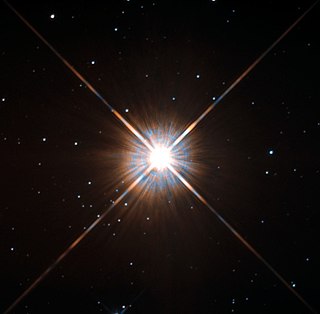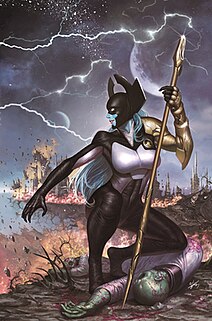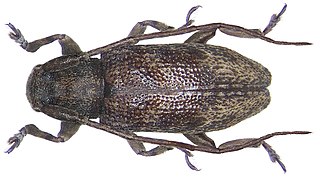
Alpha Centauri is a gravitationally bound system of the closest stars and exoplanets to Earth's Solar System at 4.37 light-years from the Sun. The name is Latinized from α Centauri, and abbreviated Alpha Cen or α Cen. It is a triple star system, consisting of the three stars: α Centauri A, α Centauri B, and the closest star α Centauri C.

Proxima Centauri is a small, low-mass star located 4.2465 light-years (1.3020 pc) away from the Sun in the southern constellation of Centaurus. Its Latin name means the "nearest [star] of Centaurus". This object was discovered in 1915 by Robert Innes and is the nearest-known star to the Sun. With a quiescent apparent magnitude 11.13, it is too faint to be seen with the unaided eye. Proxima Centauri is a member of the Alpha Centauri star system, being identified as component Alpha Centauri C, and is 2.18° to the southwest of the Alpha Centauri AB pair. It is currently 12,950 AU (0.2 ly) from AB, which it orbits with a period of about 550,000 years.

Pangaea Proxima is a possible future supercontinent configuration. Consistent with the supercontinent cycle, Pangaea Proxima could occur within the next 300 million years. This potential configuration, hypothesized by Christopher Scotese in November 1982, earned its name from its similarity to the previous Pangaea supercontinent. Scotese later changed Pangaea Ultima to Pangaea Proxima to alleviate confusion about the name Pangaea Ultima which could imply that it would be the last supercontinent. The concept was based on examination of past cycles of formation and breakup of supercontinents, not on current understanding of the mechanisms of tectonic change, which are too imprecise to project that far into the future. "It's all pretty much fantasy to start with," Scotese has said. "But it's a fun exercise to think about what might happen. And you can only do it if you have a really clear idea of why things happen in the first place."

Próxima Estación: Esperanza is an album by Manu Chao. The album was released in Europe in 2001. It was released in the United States on 5 June 2001 on Virgin Records.
Proxima may refer to one of the following:

Ropica Górna is a village in the administrative district of Gmina Sękowa, within Gorlice County, Lesser Poland Voivodeship, in southern Poland, close to the border with Slovakia. It lies approximately 4 kilometres (2 mi) east of Sękowa, 9 km (6 mi) south-east of Gorlice, and 108 km (67 mi) south-east of the regional capital Kraków.
A Próxima Vítima is a Brazilian telenovela that was produced and aired by TV Globo from March 13, 1995, to November 3, 1995, totaling 203 chapters.

Proxima Midnight is a fictional supervillain appearing in American comic books published by Marvel Comics. She is a prominent member of the Black Order, a team of aliens who work for Thanos. Created by writer Jonathan Hickman, she first appeared in New Avengers #8.

Ropica is a genus of beetles in the family Cerambycidae, containing the following species:
Ropica marmorata is a species of beetle in the family Cerambycidae. It was described by Breuning in 1939. It contains the subspecies Ropica marmorata marmorata and Ropica marmorata sarawakiana.
Ropica kaszabi is a species of beetle in the family Cerambycidae. It was described by Breuning in 1975.
Ropica sechellarum is a species of beetle in the family Cerambycidae. It was described by Breuning in 1957. It contains the subspecies Ropica sechellarum interruptefasciata and Ropica sechellarum sechellarum.
Ropica duboisi is a species of beetle in the family Cerambycidae. It was described by Fairmaire in 1850.
Ropica formosana is a species of beetle in the family Cerambycidae. It was described by Henry Walter Bates in 1866. It contains four subspecies, Ropica formosana formosana, Ropica formosana japonica, Ropica formosana nobuoi, and Ropica formosana tokaraensis.

The Black Order is a fictional supervillain team appearing in American comic books published by Marvel Comics. They are group of alien warriors with various supernatural abilities who serve Thanos. The original iteration consisted of Ebony Maw, Corvus Glaive, Proxima Midnight, Black Dwarf, Supergiant, and Black Swan.
A Próxima Atração is a Brazilian telenovela produced and broadcast by Rede Globo. It premiered on 26 October 1970 and ended on 17 April 1971, with a total of 150 episodes. It's the seventh "novela das sete" to be aired at the timeslot. It is created by Vicente Sesso and directed by Régis Cardoso.

Proxima Centauri b (also called Proxima b or Alpha Centauri Cb) is an exoplanet orbiting in the habitable zone of the red dwarf star Proxima Centauri, which is the closest star to the Sun and part of a triple star system. It is approximately 1.28 parsecs or 4.2 light-years (4.0×1013 km) from Earth in the constellation Centaurus, making it and Proxima c the closest known exoplanets to the Solar System.

Amanita proxima is a species of Amanita from France, Italy, and Spain.

Proxima Centauri c (also called Proxima c or Alpha Centauri Cc) is a very strong exoplanet candidate orbiting the red dwarf star Proxima Centauri, which is the closest star to the Sun and part of a triple star system. It is located approximately 4.2 light-years (1.3 parsecs; 4.0×1013 kilometres) from Earth in the constellation of Centaurus, making it and Proxima b the closest known exoplanets to the Solar System.

BLC1 is a candidate SETI radio signal detected and observed during April and May 2019, and first reported on 18 December 2020, spatially coincident with the direction of the Solar system's closest star, Proxima Centauri.











